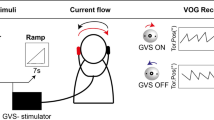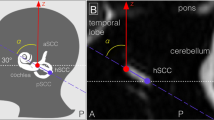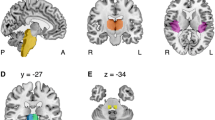Abstract
Functional MRI (f-MRI) is a non-invasive technique developed to permit functional mapping of the brain with a better temporal and spatial resolution than that offered by PET techniques. In our study, f-MRI was performed using blood oxygenation level dependent (BOLD) contrast imaging based on the magnetic properties of hemoglobin. This method relies on changes in the blood supply to the brain that accompany sensory stimulation or changes in cognitive state. All the images were obtained at 1.5 T on a Signa GEMS without ultrafast imaging. The vestibular stimulation was cold irrigation of the external auditory meatus (caloric stimulation). A population of normal healthy volunteers without a history of vestibular dysfunction was studied. The hippocampal formation as well as the retrosplenial cortex and the subiculum were activated by vestibular stimulation, suggesting that this activation may be related to spatial disorientation and a sensation of self-rotation experienced by the subjects during vestibular stimulation. The other results are similar to those obtained using PET.
Similar content being viewed by others
References
Bandettini PA, Jesmanowicz A, Wong EC, Hyde JS (1993) Processing strategies for time-course data sets in functional MRI of the human brain. Magn Reson Med 30: 161–173
Blair HT, Sharp P (1995) Anticipatory head direction signals in the anterior thalamus: evidence for a thalamocortical circuit that integrates angular head motion to compute head direction. J Neurosci 15: 6260–6270
Bottini G, Sterzi R, Paulesu E, Vallar G, Cappa SF, Erminio F, Passingham RE, Frith CD, Frackowiak RS (1994) Identification of the central vestibular projections in man: a positron emission tomography study. Exp Brain Res 99: 164–169
Bronen RA, Cheung G (1991) MR of the normal hippocampus. Magn Reson Imaging 9: 497–500
Derosier C, Caritu Y, Cordoliani YS, Cosnard G (1994) Une technique de traitement du signal en IRM pour l'imagerie fonctionnelle. J Radiol 75: 515–518
Duvernoy HM (1992) The human hippocampus: an atlas of applied anatomy, 1st ed. Bergmann, Munich
Eichenbaum H, Wiener SI, Shapiro ML, Cohen NJ (1989) The organization of spatial coding in the hippocampus: a study of neural ensemble activity. J Neurosci 9: 2764–2775
Friberg L, Olsen TS, Roland PE, Paulson OB, Lassen NA (1985) Focal increase of blood flow in the cerebral cortex of man during vestibular stimulation. Brain 108: 609–623
Gavrilov VV, Wiener S, Berthoz A (1995) Enhanced hippocampal theta EEG during whole body rotation in awake restrained rats. Neurosci Lett 197: 239–241
Grüsser OJ, Pause M, Schreiter U (1990) Localization and responses of neurons in the parieto-insular vestibular cortex of awake monkeys (Macaca fascicularis). J Physiol (Lond) 430: 537–557
Habib M, Sirigu A (1987) Pure topographical disorientation: a definition and anatomical basis. Cortex 23: 73–85
Kapur N, Friston KJ, Young A, Frith CD, Frackowiak RSJ (1995) Activation of human hippocampal formation during memory for faces: a PET study. Cortex 31: 99–108
MacNaughton BL, Knierim JJ, Wilson MA (1994) Vector encoding and the vestibular foundations of spatial cognition. In: Gazzaniga M (ed) The cognitive neurosciences, MIT Press, Boston, Mass, pp 585–595
Naidich TP, Daniels DL, Haughton VM, Williams A, Pech P (1988) The hippocampal formation and related structures of the limbic lobe: anatomic-magnetic resonance correlation. In: Gouaze A, Salamon C (eds) Brain anatomy and magnetic resonance imaging. Springer, Berlin Heidelberg New York
Ogawa S, Tank DW, Menon R, Ellermann JM, Kim SG, Merkle H, Ugurbil K (1992) Intrinsic signal changes accompanying sensory stimulation: functional brain mapping with magnetic resonance imaging. Proc Natl Acad Sci USA 89: 5951–5955
O'Mara SM, Rolls ET, Berthoz A, Kesner RP (1994) Neurons responding to whole-body motion in the primate hippocampus. J Neurosci 14: 6511–6523
Penfield W, Rasmussen T (1957) The cerebral cortex of man: a clinical study of localization of function. Macmillan, New York
Sharp PE, Blair HT, Etkin D Tzanetos DB (1995) Influences of vestibular and visual information on the spatial firing patterns of hippocampal place cells. J Neurosci 15: 173–189
Smith BH (1960) Vestibular disturbances in epilepsy. Neurology 10: 465–469
Talairach J, Tournoux P (1988) Coplanar stereotaxic atlas of the human brain. Three-dimensional proportional system: an approach to cerebral imaging. Thieme, New York
Taube JS, Muller RU, Ranck JB (1990a) Head-direction cells recorded from the post-subiculum in freely moving rats. I. Description and quantitative analysis. J Neurosci 10: 420–435
Taube JS, Muller RU, Ranck JB (1990b) Head-direction cells recorded from the post-subiculum in freely moving rats. II. Effects of environmental manipulations. J Neurosci 10: 436–447
Wiener SI, Berthoz A (1993) Forebrain structures mediating the vestibular contribution during navigation. In: Berthoz A (ed) Multisensory control of movement. Oxford University Press, Oxford, pp 427–455
Wiener SI, Korshunov VA, Garcia R, Berthoz A (1995) Inertial, substratal and landmark cue control of hippocampal CA1 place cell activity. Eur J Neurosci 7: 2206–2219
Author information
Authors and Affiliations
Rights and permissions
About this article
Cite this article
Vitte, E., Derosier, C., Caritu, Y. et al. Activation of the hippocampal formation by vestibular stimulation: a functional magnetic resonance imaging study. Exp Brain Res 112, 523–526 (1996). https://doi.org/10.1007/BF00227958
Received:
Accepted:
Issue Date:
DOI: https://doi.org/10.1007/BF00227958




